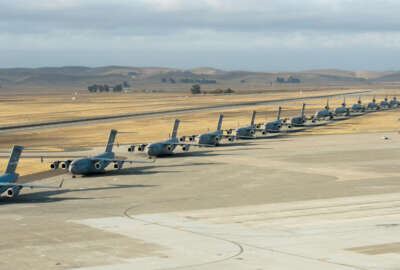To listen to the Federal Newscast on your phone or mobile device, subscribe on PodcastOne or Apple Podcasts. The best listening experience on desktop can be found using Chrome, Firefox or Safari.
- After 25 years, the General Services Administration plans to change how it verifies whether companies are eligible to do business with or receive assistance from the government. GSA awarded a five-year, $41 million contract to Ernst & Young to provide entity validation services for the federal award process. The agency said the new contract will reduce duplication and simplify the verification process. GSA had been receiving these services from Dun & Bradstreet for the last quarter of a century. (General Services Administration)
- A more thorough version of President Donald Trump’s 2020 budget request included more details about the administration’s proposed 2020 pay freeze for civilian employees. The White House again said it prefers performance-based bonuses over across-the-board pay raises. The Office of Management and Budget will issue guidance later this year on how agencies can more strategically reward top performers. The budget proposal would also revive another recommendation from 2019. The White House said it wants to cut the amount of sick and annual leave federal employees have, and move those days under one bucket. (Federal News Network)
- The president’s 2020 budget request also includes a wide variety of updates to the civil service system as the administration wants to hire more term and temporary employees. The plan would compensate them differently than the average career federal employees, by moving current and future term employees under a defined contribution plan. It also aims to expand critical skills authorities for agencies, and create an industry exchange program for top talent to move back and forth from government to the private sector. (Federal News Network)
- The proposal also looked into helping the IRS save up to $56 billion over the next decade, through increased tax oversight. The budget would allow the agency to set higher standards for paid tax preparers. It also proposed giving the IRS more discretion to correct errors on tax returns, beyond simple math mistakes. (White House)
- Federal spending on IT for fiscal 2020 may be going down overall, but most agencies would see more money. Agencies requested about $200 million less in 2020 than in 2019 for federal IT. But a strong majority of the civilian agencies will see increases, in some cases pretty large ones. Overall civilian IT spending would rise to $51 billion next year if the Trump administration gets its way. In 2019, the administration requested $46.7 billion for civilian IT spending. The Defense Department would account for most of the overall decrease. It is facing a cut of $1.2 billion in 2020. (White House)
- Federal real property disposal would be simpler under a proposal from the Trump administration. In its 2020 budget analysis, the administration said progress on getting rid of excess property has slowed down because the easiest disposal candidates are gone. It asked Congress to amend Title 40 by eliminating agencies’ obligations to find worthy places to donate property. Instead, agencies could render a property excess and proceed directly to a sale. The administration said that would be a better deal for taxpayers. (White House)
- The Air Force wants to increase the money it spends on recapitalizing and modernizing its installations by two percent per year. A new strategy would turn the tides on the Air Force’s $33 billion in deferred installations maintenance. Air Force leaders said the installation issue is starting to affect readiness. The Air Force also wanted to use big data to better predict when to perform regular maintenance on installations so they last longer. (Federal News Network)
- The Pentagon requested nearly $23 billion for its military intelligence program in 2020. For the fifth year in a row, DoD wanted more funds for its so-called black budget. The account pays for special operations activities and advanced intelligence, surveillance and reconnaissance, among other intelligence-related items. (Department of Defense)
- About 1,000 Department of Homeland Security employees will be moved to the agency’s Saint Elizabeth’s campus in southeast Washington, D.C., between March and April. Those employees include staff from the office of the secretary and executive management, as well as employees from the agency’s office of operations coordination. DHS and GSA, as part of the fiscal 2020 budget request, together asked lawmakers for more than $400 million for Saint Elizabeth’s construction. (Federal News Network)
- The new personnel system DoD set up for its cyber workforce has dramatically accelerated the process of bringing new civilian workers onboard. The Cyber Excepted Service is still in its infancy, even though Congress authorized it more than three years ago. But U.S. Cyber Command said its average hiring time has fallen from 111 days to just 44 days since it adopted CES. The Pentagon wants to expand the system to eventually cover some 15,000 workers across the military services, but it has a long way to go. So far, it’s only converted 400 jobs to the excepted service. (Federal News Network)
- After two men died of carbon dioxide poisoning in a public housing complex in South Carolina, one of the state’s congressional members wants the Department of Housing and Urban Development to provide carbon monoxide detectors in all of its units. Rep. Joe Cunningham (D-S.C.) introduced the Safe Housing for Families Act to require HUD to put the devices in place. Carbon monoxide poisoning has led to at least 11 deaths in HUD housing since 2003. (Rep. Joe Cunningham)
Copyright
© 2025 Federal News Network. All rights reserved. This website is not intended for users located within the European Economic Area.




